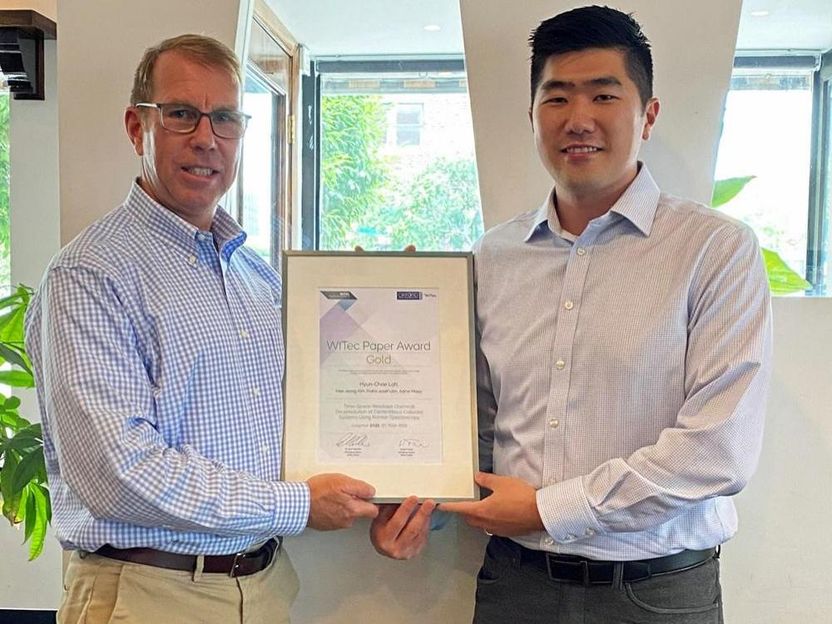WITec announces Paper Award 2022 winners
The prizes go to scientists from the US, Germany and China
Advertisement
The WITec Paper Awards 2022 have been given to scientists from the US, Germany and China, recognizing their work in cement chemistry, pharmacy and methane hydrate chemistry. Every year, the WITec Paper Award highlights three scientific publications that contain data acquired with a WITec microscope. More than 100 papers were submitted to this year’s contest. WITec congratulates the winners and thanks all the participants.

Hyun-Chae Loh from MIT in Cambridge, Massachusetts (right) receives the WITec Paper Award Gold certificate from Michael C. Lipton, Oxford Instruments Regional Sales Manager (left).

Official handing over of the Paper Award Silver certificate. From left to right: WITec Sales Manager Stefan Gomes da Costa and Nathalie Jung, Maike Windbergs and Francesco Pampaloni from the Goethe-University in Frankfurt am Main, Germany.

The WITec Paper Award Bronze winner Xin Huang (middle) with his co-workers Le Zhang (left) and Jiayuan He (right) from the SINOPEC Petroleum Exploration and Production Research Institute in Beijing, China.



- GOLD: Hyun-Chae Loh, Hee-Jeong Kim, Franz-Josef Ulm, Admir Masic (2021) Time-space-resolved chemical deconvolution of cementitious colloidal systems using Raman spectroscopy. Langmuir 37: 7019-7031.
- SILVER: Nathalie Jung, Till Moreth, Ernst H. K. Stelzer, Francesco Pampaloni, Maike Windbergs (2021) Non-invasive analysis of pancreas organoids in synthetic hydrogels defines material-cell interactions and luminal composition. Biomaterials Science 9: 5415-5426.
- BRONZE: Xin Huang, Le Zhang, Wenjiu Cai, Jiayuan He, Hailong Lu (2022) Study on the characteristic spectral bands of water molecule and hydrogen bond of methane hydrate. Chemical Engineering Science 248: 117117 (available online 2021).
The Paper Award GOLD: Hydration kinetics of cement
Concrete is used extensively in construction due to its durability and strength. It forms in a chemical reaction of cement with water and fresh concrete can still be molded during the setting process. In order to optimize the material properties, including the setting time, a thorough understanding of the hydration reaction of cement is required. Hyun-Chae Loh wins the Gold Paper Award 2022 for investigating the early hydration kinetics of ordinary Portland cement together with his colleagues Hee-Jeong Kim, Franz-Josef Ulm and Admir Masic from the Department of Civil and Environmental Engineering at the Massachusetts Institute of Technology in Cambridge, USA. The group used in situ underwater Raman microscopy for monitoring the transformation of the silicate phases into hydration products during cement setting. Using two-point correlation functions of the Raman images, the reaction kinetics could be quantified. This spatio-temporal analysis yielded mechanistic insights into the cement setting, supporting the theory of a percolation process. “Our approach is also applicable to other aspects of cement chemistry,” says Admir Masic. “For example, the roles of sulfate, aluminate and carbonate phases in cement setting will be the subject of future publications.”
The Paper Award SILVER: Organoid formation
From basic research to personalized medicine, well-defined model systems are critically important for understanding human diseases and developing therapies. In this context, so-called organoids have great potential, as these 3D microstructures have organ-like properties. These 3D cell cultures are typically grown in hydrogels, artificial matrices that provide the scaffolding for organoid formation. Nathalie Jung and Till Seeberger (né Moreth) win the Silver Paper Award 2022 for presenting Raman imaging as a non-invasive method for characterizing organoid formation in different environments. They performed the study together with their colleagues Ernst H. K. Stelzer, Francesco Pampaloni and Maike Windbergs at the Institute of Pharmaceutical Technology and the Buchmann Institute for Molecular Life Sciences at the Goethe-University in Frankfurt am Main, Germany. Pancreatic organoids were grown in different hydrogels and their growth rates, composition and matrix interactions were characterized. “The advantage of Raman microscopy is that even native cell cultures can be investigated without time-consuming and destructive sample preparation,” explains Nathalie Jung. This approach enabled the authors to compare organoid formation in different hydrogels and select the most promising formulations. The technique can also be used for investigating the chemical composition of the organoid lumen, monitoring compound secretion and the effect of drugs on the living cells.
The Paper Award BRONZE: Methane hydrate formation
Methane hydrate is an ice-like solid consisting of methane molecules trapped in the water crystal structure. Naturally occurring methane hydrate reservoirs are potential energy sources, but may contribute to global warming if released into the atmosphere. Xin Huang receives the Bronze Paper Award 2022 for his detailed characterization and interpretation of the Raman spectral changes during methane hydrate formation, performed with his co-workers Le Zhang, Wenjiu Cai, Jiayuan He and Hailong Lu. The study was a collaboration between two institutions in Beijing, China: the SINOPEC Petroleum Exploration and Production Research Institute and the Beijing International Center for Gas Hydrate at Beijing University. The scientists recorded Raman spectra from within a reactor in which methane hydrate formed under controlled conditions. Focusing on spectral features of the water molecules, they identified and interpreted several spectral indicators of hydrate formation. Of note, the phase transition was marked by an abrupt change in the spectral region representing hydrogen bond vibrations. Changes in the stretching vibrations of hydrogen-oxygen bonds were also analyzed quantitatively. The authors are convinced that their approach “can be widely used in laboratory research and field hydrate exploration.”
Original publication
Hyun-Chae Loh, Hee-Jeong Kim, Franz-Josef Ulm, Admir Masic (2021) Time-space-resolved chemical deconvolution of cementitious colloidal systems using Raman spectroscopy. Langmuir 37: 7019-7031.
Nathalie Jung, Till Moreth, Ernst H. K. Stelzer, Francesco Pampaloni, Maike Windbergs (2021) Non-invasive analysis of pancreas organoids in synthetic hydrogels defines material-cell interactions and luminal composition. Biomaterials Science 9: 5415-5426.
Xin Huang, Le Zhang, Wenjiu Cai, Jiayuan He, Hailong Lu (2022) Study on the characteristic spectral bands of water molecule and hydrogen bond of methane hydrate. Chemical Engineering Science 248: 117117 (available online 2021).


























































